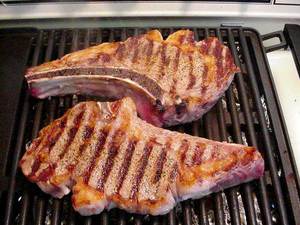If you are like me, you have a ten-year-old Weber kettle that serves as your spring and summer alter of meat. Now, don’t get me wrong: I love the ritual of and the food that comes off of the backyard grill. I just have not yet gotten around to getting a fancier one, so the old Weber keeps going.
And why not? Weber Kettles are the single greatest innovation in the history of back-yard charcoal grilling. With skillful heat management, you can grill, roast, grill-smoke, and, in some cases, very nearly simulate true barbecue. Living in California, I use mine through the autumn and up until the rainy season – and sometimes then too!
Your old workhorse of a Weber, however, needs some tender loving care now and then. Here are a few suggestions to keep the old grill going.
1) Wash everything down with the garden hose, and take your Weber down to its component parts: the legs and wheels, the charcoal bucket, the grills (both charcoal and cooking) the lid and the ash pan.
2) Inside the charcoal bucket and the lid, scrub the ash with a wire brush. This should be done before you put her away for the off season, as moisture combined with the ash makes a very effective acid that will end up eating through the chassis. Because of that, I like to use a cleaning solution for the interior that includes a healthy dose of baking soda to neutralize the acid. If you did not do it last fall, however, this is the time to get it sparklingly clean.
3) Put the charcoal grill through the self-cleaning cycle of your oven, if you want. This is completely superfluous, but it will help to get any of the weird goo off that may have accumulated.
4) Get out the Mr. Clean, or any other surface cleaner, and make a bucket of sudsy water and give the entire outer surface a loving bath. I like to go over it in the shade with a Windex or white vinegar wipe-down after, to give it a nice sheen, but avoid the urge to give her a coat of Turtle Wax. Believe me, I speak from experience.
5) Now that everything is clean as a whistle, give all the parts a thorough examination. Are the wooden handles still in good condition? The wheels and the ash-pan? How do the welds look? Any welding shop can make the simple fixes that might be necessary to a Weber, or it is a good place for the home welder to practice. Parts for Weber Kettles, such as Wood handles, replacement grills, wheels and ash-pans are available through most hardware stores that carry Weber products.
6) If your best grill is in need of new paint, do not panic. If you don’t have an air compressor, you can use spray paint to great effect, just be sure to get heat resistant paint. If you are going to do pin-striping or paint your sweetheart’s name on your grill, see what heat resistant metallics are available – otherwise you will end up with an unsightly scorch where it once said “Mom”.
7) Examine the cooking surface carefully and see if you can get it truly clean. I generally keep two grills in rotation for the Weber: One exclusively for fish, and it is in like-new condition and I keep it pristinely clean. The second is for everything else, and it is the retired fish grill from the year before. New cooking grills are available for your Weber, again, at the local hardware store, and they come in all types and styles. Plain grills or grills with lift-up sides so you may conveniently add fresh charcoal during long cooking sessions. Additionally, for those of us who are on a budget, Wal Mart makes generic grills that will fit the standard sized Webers at half the price of the genuine articles.
8) Reassemble carefully and completely. At this point, you might want to spring for a cover too – that will keep your grill in nice condition throughout the barbecue season.



